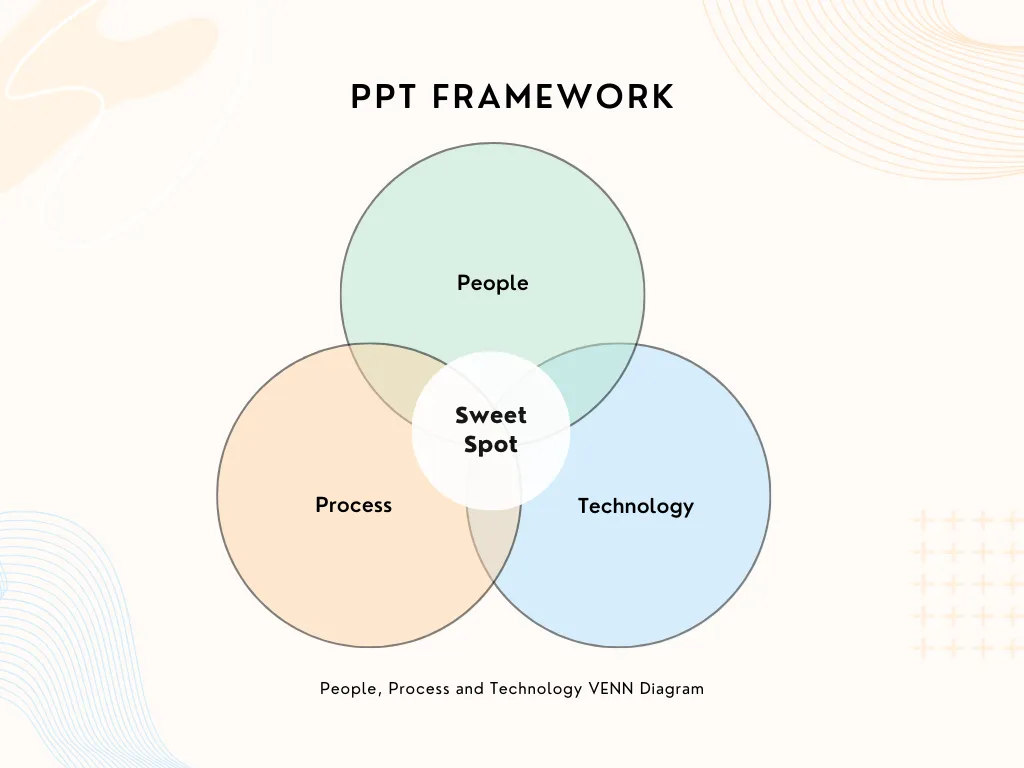My favorite VENN diagram.

I learned to use the People, Process and Technology framework when I worked as an IT Quality Assurance Specialist in a Project Office group for an Information Technology division of NB Power. #PPT may be referred to as, the golden triangle or the three legged stool model. The models can be used as part of a Business Process Intelligence initiative, troubleshooting issues and improving business operational efficiencies. The goal is to balance the primary elements supporting your business operation. When balanced, you will improve operational efficiency, reduce cost and increase quality of deliverables.
When I introduced Project ePayTraffic to Hive, in March 2023, I provided an outline of a process improvement initiate.
@fjworld/pept-lays-out-a-5-point-process-improvement-strategy
Those improvements will come from using a PPT Framework to ensure the highest quality deliverables. The framework is applied to existing projects, new projects and operational systems supporting every aspect of FJ World Inc business operation.
I also use the PPT framework to analyze the root causes of unwanted problems by examining how each element contributes to the problem and how they can be improved. There is no definitive answer to which category would be more likely to be at fault, since it depends on context and situation of the problem. In my experience, the people element has often been the more challenging when senior management of an organization is not fully supportive of continuous process improvement initiatives.
People are the human resources who perform the tasks and use the technology. They can be affected by factors such as skills, knowledge, motivation, communication, collaboration, culture, etc. Some common root causes related to people are lack of training, unclear roles and responsibilities, poor leadership, low morale, etc.
Process is the set of activities and procedures that people follow to achieve a goal or outcome. It can be affected by factors such as efficiency, effectiveness, quality, consistency, compliance, etc. Some common root causes related to process are outdated or missing documentation, unnecessary steps or delays, lack of feedback or monitoring, misalignment with goals or expectations, etc.
Technology is the tools and systems that people use to support or automate the process. It can be affected by factors such as functionality, reliability, usability, security, integration, scalability, etc. Some common root causes related to technology are malfunctioning or incompatible hardware or software, insufficient or outdated resources, lack of support or maintenance, user errors or misuse, etc.
The following steps are typically used to analyze root causes of problems.
- Define the problem clearly and specifically.
- Identify the people involved or affected by the problem and their roles and responsibilities.
- Identify the process that is related to the problem and map out its steps and inputs and outputs.
- Identify the technology that is used or needed for the process and its features and functions.
- For each element of PPT, ask why the problem occurred and what factors contributed to it. Use tools such as brainstorming, fishbone diagrams, 5 whys analysis, etc. to generate possible causes.
- Evaluate the causes and prioritize them based on their impact and frequency. Use tools such as Pareto charts, risk matrices, SWOT analysis, etc. to rank the causes.
- For each cause, identify possible solutions or improvements that can address it. Use tools such as SMART goals, action plans, PDCA cycles, etc. to plan and implement the solutions.
- Monitor and measure the results of the solutions and check if they solved the problem or reduced its severity. Use tools such as KPIs, dashboards, surveys, feedback loops, etc. to track and evaluate the outcomes.
As we move along our traffic exchange improvement journey, there will be many opportunities for our community subscribers to engage, contribute and be rewarded for their contribution. Plus, if you are a holder of PEPT tokens then your engagement will be reflected in the value growth of our community token.
This completes the overview of PPT Framework. Hopefully it will help you look at your daily activities in a different way. I know it has been very effective in helping me evaluate technology usage. All too often you see business processes designed around a technology in a way to satisfy the requirements of the technology. These imbalances are indications of incipient problems in a system. So your business may do very well in the short term but as time goes on it becomes more difficult to generate the same returns as previous quarters. Something to thing about.
To our success,
Jack